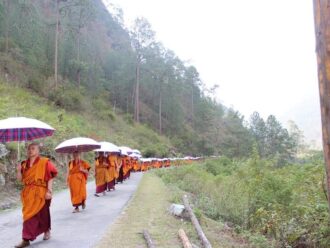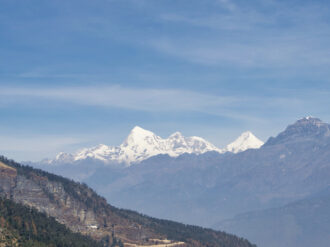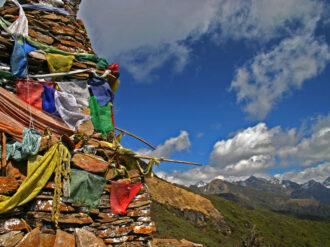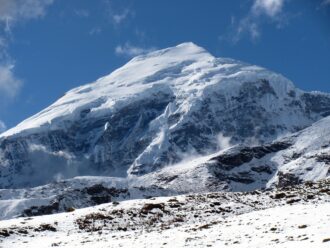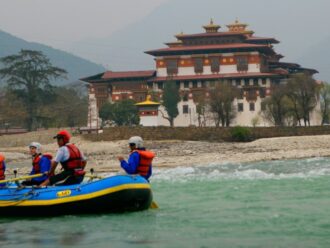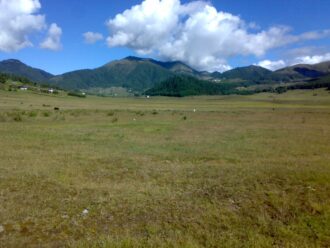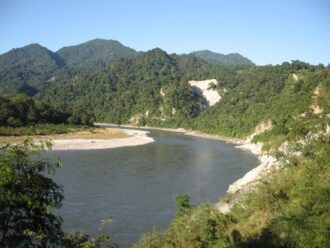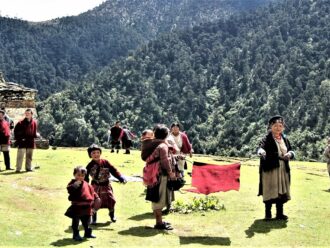Merak and Sakten Trek
Colourful trek in the months of April to May
Day 01
Trashigang – Chaling (7050ft) –Shatimi (8270ft)/Damnongchu (10131ft)
An hour’s drive through Rangjung will take you to Chaling village. It’s a farm road offering you a bumpy ride. On this trek there are two camping areas namely Shatimi and Damnongchhu. Those who had a late start can halt at Shatimi. From Shatimi it is a gradual climb to Damnongchhu. To camp here we need to cross Mindrula pass (10,880ft). The total trek time is close to 7 hours. The kind of vegetation are deciduous as we start and temperate as we camp. Lots of magnolias and rhododendron species abound here. Make a colourful trek in the months of April to May. But high altitude rhododendrons stay in bloom even till late July. Look out for Himalayan black bears in autumn and beautiful pheasants in spring.
Day 02
Damnongchu – Merak (11480ft)
We start from Damnongchu at leisure as the trekking time is little over 5 hours. Enjoy the trek through yak meadows with legendary stories dating back before Buddhism reached Bhutan. From the fir and spruce vegetation we climb to alpine meadows. Merak is a high altitude village. The lifestyle is semi nomadic. The farmers have permanent houses in Merak but move from meadows to meadows with their yaks, Dzos and sheep. Dzos are cross-breed between yaks and domestic cow. These creatures are strong and are used as beast of burden. Merak people are devout animists. For them Aum Jomo is the highest deity. Aum Jomo is considered as the protective deity of fauna. Merak people’s livelihood is from sheep, cows and yaks. It is vitally important that deities like Aum Jomo are worshiped. The Jomo ritual happens in summer. The Merak people have a custom of offering Ara (distilled alcohol from corn). Enjoy your afternoon with the special nomads of Merak.
Day 03
Merak – Miksa Teng (9400ft)
The trek from Merak to Miksa Teng is not so strenous. It will pass through the beautiful Nagchungla pass at 14,500ft. We climb up and gain almost 3000ft. The vegetation is mainly shrubs of rhododendron species. As you get on the pass, which is like a long ridge, one can feel the altitude gain. The pass is quite chilly and you need warm gear even in summer months. The biggest highlight is the fantastic panoramic views of the other Himalayas. The pass is covered with beautiful blooms in June and July of rhododendron species. Today’s trek is little over 7 hours and considered tough because of the altitude. Right after the Nagchungla pass we have a steep descent. The altitude drop from the pass till Miksa Teng camp is 5100ft. Lots of grabbles and legend says that even horses cry if the trek is from Sakten to Merak. The name Nagchungla is translated as the pass where men and horses cry. We are lucky to be doing the right way. We settle our camp at Miksa Teng which is a beautiful area by a stream.
Day 04
Miksa Teng – Sakteng (9850ft)
Trek to Sakteng from Miksa Teng is easy making your way through beautiful woods with a short climb before reaching the camp. Sakteng is fairly bigger than Merak. The centre of the village is the Sakten Nagtsang which is the biggest house. All village ceremonies are conducted in this house. In the event campers have no tents this can be an ideal night refuge. The trek today is almost 4 hours and we can reach our destination for lunch. After lunch, we have all the time to jostle with Sakten villagers or take a walk over the ridge beyond the village.
Day 05
Sakteng– JyonkharTeng (6100ft)
Farewell to the beautiful nomadic scenery of Sakten. Today’s trail is much easier than what we had so far. It is mostly downhill and walking on well maintained horse trails. Most part of today is through forests of magnolias. There are parts where bamboos grow so tall and solitary walking can be a little eerie. So walk in pairs or in groups. There are stories of tiger sighting on this trail. We will be trekking for close to 7 hours as we hit the campsite at Jyonkhar Teng. After your tea you can venture to the village and see how the community school operates. Jyonkhar Teng campsite is located near a river.
Day 06
Jyonkhar – 5hrs – Phongmey/Radhi(6500ft)
Within 5 hours we can make to Phongmey village and then proceed to Radhi. Radhi, popularly known as the 'Rice Bowl' of the east is popular for raw silk textiles called Bura weaving. This is a colourful village and it is worth to camp here. It is a warm area situated at 6500ft. For those who wish to end the trek faster can drive to Trashigang. It takes an hour on the feeder road and then onto a paved road.
